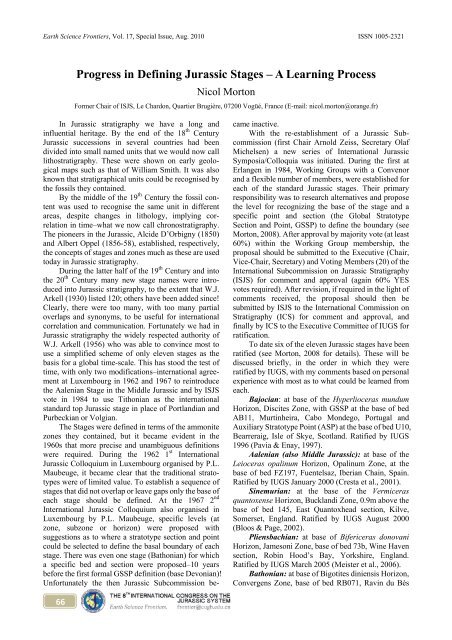in Jurassic and Cretaceous Stratigraphy
in Jurassic and Cretaceous Stratigraphy
in Jurassic and Cretaceous Stratigraphy
Create successful ePaper yourself
Turn your PDF publications into a flip-book with our unique Google optimized e-Paper software.
Earth Science Frontiers, Vol. 17, Special Issue, Aug. 2010 ISSN 1005-2321<br />
66<br />
Progress <strong>in</strong> Def<strong>in</strong><strong>in</strong>g <strong>Jurassic</strong> Stages – A Learn<strong>in</strong>g Process<br />
Nicol Morton<br />
Former Chair of ISJS, Le Chardon, Quartier Brugière, 07200 Vogüé, France (E-mail: nicol.morton@orange.fr)<br />
In <strong>Jurassic</strong> stratigraphy we have a long <strong>and</strong><br />
<strong>in</strong>fluential heritage. By the end of the 18 th Century<br />
<strong>Jurassic</strong> successions <strong>in</strong> several countries had been<br />
divided <strong>in</strong>to small named units that we would now call<br />
lithostratigraphy. These were shown on early geolo-<br />
gical maps such as that of William Smith. It was also<br />
known that stratigraphical units could be recognised by<br />
the fossils they conta<strong>in</strong>ed.<br />
By the middle of the 19 th Century the fossil con-<br />
tent was used to recognise the same unit <strong>in</strong> different<br />
areas, despite changes <strong>in</strong> lithology, imply<strong>in</strong>g cor-<br />
relation <strong>in</strong> time–what we now call chronostratigraphy.<br />
The pioneers <strong>in</strong> the <strong>Jurassic</strong>, Alcide D’Orbigny (1850)<br />
<strong>and</strong> Albert Oppel (1856-58), established, respectively,<br />
the concepts of stages <strong>and</strong> zones much as these are used<br />
today <strong>in</strong> <strong>Jurassic</strong> stratigraphy.<br />
Dur<strong>in</strong>g the latter half of the 19 th Century <strong>and</strong> <strong>in</strong>to<br />
the 20 th Century many new stage names were <strong>in</strong>tro-<br />
duced <strong>in</strong>to <strong>Jurassic</strong> stratigraphy, to the extent that W.J.<br />
Arkell (1930) listed 120; others have been added s<strong>in</strong>ce!<br />
Clearly, there were too many, with too many partial<br />
overlaps <strong>and</strong> synonyms, to be useful for <strong>in</strong>ternational<br />
correlation <strong>and</strong> communication. Fortunately we had <strong>in</strong><br />
<strong>Jurassic</strong> stratigraphy the widely respected authority of<br />
W.J. Arkell (1956) who was able to conv<strong>in</strong>ce most to<br />
use a simplified scheme of only eleven stages as the<br />
basis for a global time-scale. This has stood the test of<br />
time, with only two modifications–<strong>in</strong>ternational agree-<br />
ment at Luxembourg <strong>in</strong> 1962 <strong>and</strong> 1967 to re<strong>in</strong>troduce<br />
the Aalenian Stage <strong>in</strong> the Middle <strong>Jurassic</strong> <strong>and</strong> by ISJS<br />
vote <strong>in</strong> 1984 to use Tithonian as the <strong>in</strong>ternational<br />
st<strong>and</strong>ard top <strong>Jurassic</strong> stage <strong>in</strong> place of Portl<strong>and</strong>ian <strong>and</strong><br />
Purbeckian or Volgian.<br />
The Stages were def<strong>in</strong>ed <strong>in</strong> terms of the ammonite<br />
zones they conta<strong>in</strong>ed, but it became evident <strong>in</strong> the<br />
1960s that more precise <strong>and</strong> unambiguous def<strong>in</strong>itions<br />
were required. Dur<strong>in</strong>g the 1962 1 st International<br />
<strong>Jurassic</strong> Colloquium <strong>in</strong> Luxembourg organised by P.L.<br />
Maubeuge, it became clear that the traditional strato-<br />
types were of limited value. To establish a sequence of<br />
stages that did not overlap or leave gaps only the base of<br />
each stage should be def<strong>in</strong>ed. At the 1967 2 nd<br />
International <strong>Jurassic</strong> Colloquium also organised <strong>in</strong><br />
Luxembourg by P.L. Maubeuge, specific levels (at<br />
zone, subzone or horizon) were proposed with<br />
suggestions as to where a stratotype section <strong>and</strong> po<strong>in</strong>t<br />
could be selected to def<strong>in</strong>e the basal boundary of each<br />
stage. There was even one stage (Bathonian) for which<br />
a specific bed <strong>and</strong> section were proposed–10 years<br />
before the first formal GSSP def<strong>in</strong>ition (base Devonian)!<br />
Unfortunately the then <strong>Jurassic</strong> Subcommission be-<br />
came <strong>in</strong>active.<br />
With the re-establishment of a <strong>Jurassic</strong> Sub-<br />
commission (first Chair Arnold Zeiss, Secretary Olaf<br />
Michelsen) a new series of International <strong>Jurassic</strong><br />
Symposia/Colloquia was <strong>in</strong>itiated. Dur<strong>in</strong>g the first at<br />
Erlangen <strong>in</strong> 1984, Work<strong>in</strong>g Groups with a Convenor<br />
<strong>and</strong> a flexible number of members, were established for<br />
each of the st<strong>and</strong>ard <strong>Jurassic</strong> stages. Their primary<br />
responsibility was to research alternatives <strong>and</strong> propose<br />
the level for recogniz<strong>in</strong>g the base of the stage <strong>and</strong> a<br />
specific po<strong>in</strong>t <strong>and</strong> section (the Global Stratotype<br />
Section <strong>and</strong> Po<strong>in</strong>t, GSSP) to def<strong>in</strong>e the boundary (see<br />
Morton, 2008). After approval by majority vote (at least<br />
60%) with<strong>in</strong> the Work<strong>in</strong>g Group membership, the<br />
proposal should be submitted to the Executive (Chair,<br />
Vice-Chair, Secretary) <strong>and</strong> Vot<strong>in</strong>g Members (20) of the<br />
International Subcommission on <strong>Jurassic</strong> <strong>Stratigraphy</strong><br />
(ISJS) for comment <strong>and</strong> approval (aga<strong>in</strong> 60% YES<br />
votes required). After revision, if required <strong>in</strong> the light of<br />
comments received, the proposal should then be<br />
submitted by ISJS to the International Commission on<br />
<strong>Stratigraphy</strong> (ICS) for comment <strong>and</strong> approval, <strong>and</strong><br />
f<strong>in</strong>ally by ICS to the Executive Committee of IUGS for<br />
ratification.<br />
To date six of the eleven <strong>Jurassic</strong> stages have been<br />
ratified (see Morton, 2008 for details). These will be<br />
discussed briefly, <strong>in</strong> the order <strong>in</strong> which they were<br />
ratified by IUGS, with my comments based on personal<br />
experience with most as to what could be learned from<br />
each.<br />
Bajocian: at base of the Hyperlioceras mundum<br />
Horizon, Discites Zone, with GSSP at the base of bed<br />
AB11, Murt<strong>in</strong>heira, Cabo Mondego, Portugal <strong>and</strong><br />
Auxiliary Stratotype Po<strong>in</strong>t (ASP) at the base of bed U10,<br />
Bearreraig, Isle of Skye, Scotl<strong>and</strong>. Ratified by IUGS<br />
1996 (Pavia & Enay, 1997).<br />
Aalenian (also Middle <strong>Jurassic</strong>): at base of the<br />
Leioceras opal<strong>in</strong>um Horizon, Opal<strong>in</strong>um Zone, at the<br />
base of bed FZ197, Fuentelsaz, Iberian Cha<strong>in</strong>, Spa<strong>in</strong>.<br />
Ratified by IUGS January 2000 (Cresta et al., 2001).<br />
S<strong>in</strong>emurian: at the base of the Vermiceras<br />
quantoxense Horizon, Buckl<strong>and</strong>i Zone, 0.9m above the<br />
base of bed 145, East Quantoxhead section, Kilve,<br />
Somerset, Engl<strong>and</strong>. Ratified by IUGS August 2000<br />
(Bloos & Page, 2002).<br />
Pliensbachian: at base of Bifericeras donovani<br />
Horizon, Jamesoni Zone, base of bed 73b, W<strong>in</strong>e Haven<br />
section, Rob<strong>in</strong> Hood’s Bay, Yorkshire, Engl<strong>and</strong>.<br />
Ratified by IUGS March 2005 (Meister et al., 2006).<br />
Bathonian: at base of Bigotites d<strong>in</strong>iensis Horizon,<br />
Convergens Zone, base of bed RB071, Rav<strong>in</strong> du Bès

















